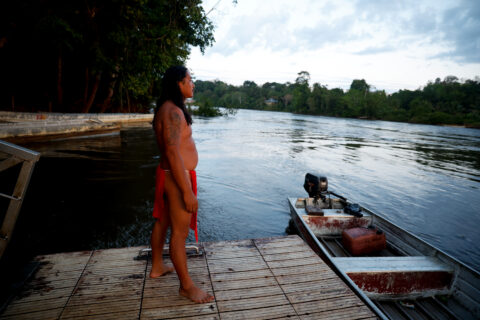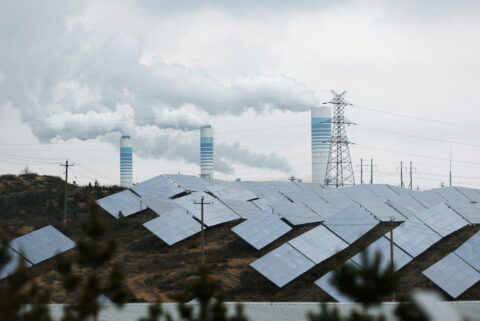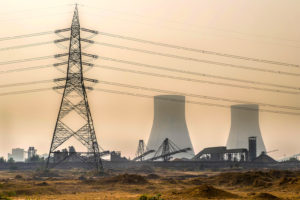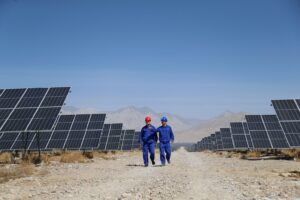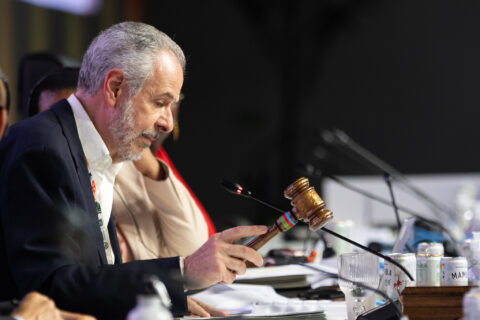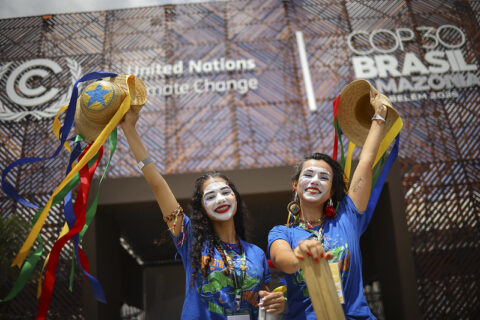For over a decade, Indigenous and local communities have demanded a bigger share of international funding to protect nature and the climate, as well as easier access to that money. But progress has been limited, with only 1-2 percent of such finance reaching them directly, reports show.
Now frustrated Indigenous rights groups are trying a new tactic to speed up change: creating their own funds in a push to boost the flow of money to frontline communities and shift away from what some see as an outdated colonial-style model driven by donors in the Global North.
Since 2020 – and especially last year – more than half a dozen new Indigenous-led funds have sprung up, largely in forest-rich Brazil but also in developing countries from Indonesia to Mexico.
Many are still in a start-up phase, but a few have already begun pushing money to frontline communities. They include the Mesoamerican Territorial Fund (MTF), which invested $1.3 million in 32 projects – from chocolate production to tourism and protecting traditional knowledge – in communities from Mexico to Panama last year.
“We are aiming not only to make the funds reach the real guardians of the forest and the real guardians of mitigating and adapting to climate change, but also to support sustainability, democracy and good governance of all these territories,” said María Pía Hernández, a lawyer and regional manager for the MTF.
World Bank climate funding greens African hotels while fishermen sink
Multilateral funds can take years to approve projects and often struggle to funnel big pots of nature and climate finance into the smaller-scale projects communities need, Indigenous leaders said.
The new funds aim to fill the gap by gathering large amounts of money, distributing it nimbly and leap-frogging the barriers faced by forest communities in dealing with traditional funds, such as onerous paperwork.
“We aim to improve not just the condition of the territories and people who live there but also promote global climatic justice,” Hernández said on the sidelines of last week’s Skoll World Forum, a gathering of social innovators.
Bypassing the giants
As the World Bank and International Monetary Fund hold their Spring Meetings in Washington this week, focused in part on reshaping lending for climate action, Indigenous communities are already rethinking how to better access the resources they need to protect nature and the climate – and to ensure those on the frontline benefit from changes such as new clean energy infrastructure.
Along the way, they are setting up new rules and structures in line with their own traditions and beliefs, after years of chafing against constraints imposed by big donors, some of them former colonial powers.
In Canada, for instance, many Indigenous governing bodies now run their own renewable energy utilities, providing a fifth of Canada’s renewables, said Joan Carling, executive director of Indigenous Peoples Rights International.
“If we transform the business-as-usual and create the enabling environment and conditions to put Indigenous people at the centre of this, then we can have a truly just, equitable renewable energy for all,” she said.
A new dashboard released last week by the Rights and Resources Initiative and the Rainforest Foundation Norway shows climate finance for indigenous and local communities rose between 2020 and 2023 to about $517 million per year, a 36 percent increase over the previous four years.
That increase comes after governments and charitable donors promised $1.7 billion back in 2021 to Indigenous and local communities by 2025 for their role in protecting land and forests, which are considered key to protecting both the climate and biodiversity.
Yet with much new funding still moving through big international environment organisations and other intermediary agencies, rather than directly to communities, “there is no evidence yet indicating a systematic change in funding modalities,” the groups noted in a report.
Connecting communities with cash
Solange Bandiaky-Badji, coordinator of the Rights and Resources Initiative, said improving direct access to funding is the key issue. At least $10 billion in finance for Indigenous and local communities will be needed to meet a global pledge to protect at least 30 percent of the planet’s land and oceans by 2030, she added.
Indigenous-led funds believe they can be pivotal to achieving that ramp-up.
Shandia, established by the Global Alliance of Territorial Communities uniting 35 million people from 24 countries, is still in a start-up phase but aims to serve as a conduit for much larger-scale finance to Indigenous and other frontline groups.
“Millions of dollars are moving in the world. We want to connect claims on the ground to those millions,” said Juan Carlos Jintiach, a Shuar indigenous leader from Ecuador and the alliance’s executive secretary, who was shortlisted for the Nobel Peace Prize last year for his work on behalf of Indigenous communities.
Indonesia’s main Indigenous alliance similarly in 2023 helped establish the Nusantara Fund, while in Brazil a range of Indigenous-led vehicles, including the Podáali Indigenous Amazonian Fund, were launched last year.
Guardians of the forest – and finance?
Anthony Bebbington, who runs the Ford Foundation’s international natural resources and change change programmes, said the last few years had seen the emergence of substantial new funds, with the potential to grow, that are challenging the traditional ways donors have worked.
“Funds are saying to us, ‘If you trust us to be guardians of the forest – a role for which we are often harassed and sometimes killed – then there is no justification for you to also not trust us to be guardians of the finance’,” he told an event on the sidelines of the Skoll World Forum.
In projects backed by the Mesoamerican Territorial Fund, for instance, indicators of success are changing from a simple focus on hectares of forest replanted to include things like whether more water is flowing through key rivers, said Hernández, whose fund so far gets 80 percent of its support from philanthropies.

An Indigenous Ramas man lifts a crayfish trap in the Rio Indio river, San Juan de Nicaragua, Nicaragua on February 16, 2022.(Photo: Reuters/Antoine Boureau/Hans Lucas)
The MTF also actively seeks out and helps prepare applications from Indigenous and local communities that could benefit from its support rather than just accepting grant proposals, as traditional donors often do.
David Rothschild, senior director of partnerships for Nia Tero, a US non-profit that works with Indigenous groups, said avoiding heavy paperwork was key to enabling the new funds take off.
“What they don’t want is to become another entity in the system operating in a colonial way. How do they not fall into the same patterns that have been destructive, while still reporting to donors?” he asked.
Hernández said new ways of working are developing, if sometimes too slowly. “We are not asking for blank cheques,” she emphasised. “But we deserve a little bit of consideration.”
(Reporting by Laurie Goering; editing by Megan Rowling)
The post As donors dither, Indigenous funds seek to decolonise green finance appeared first on Climate Home News.
As donors dither, Indigenous funds seek to decolonise green finance
Climate Change
Saudi Arabia and COP31 host Türkiye move to weaken climate language at UNEA
Turkish officials in talks for the UN Environment Assembly (UNEA) sought to weaken language on climate change in several draft resolutions, annotated documents seen by Climate Home News show.
Often working alongside Saudi Arabia, Türkiye – host of COP31 next year – pushed to dilute wording on the climate crisis, the science of melting glaciers, and the role of young and Indigenous people, as well as on support for developing nations, in texts being prepared for approval in Nairobi this week. The final versions are still being worked out.
When asked about the issue by Climate Home News, a UN official close to the negotiations said that “certain countries” that don’t want climate change to be mentioned are now “more emboldened than they were ever before to come forward and protect their national interests”.
Türkiye’s actions have raised concern in particular. “It’s rather surprising,” said Öykü Senlen Gundogan, an analyst at think-tank E3G. “Senior Turkish politicians have often called climate change a crisis, and Türkiye is among the countries most exposed to its impacts.”
Türkiye will host COP31 in the city of Antalya in November 2026 and the meeting is expected to be presided over by Turkish environment minister Murat Kurum, but Australia’s Chris Bowen will lead the negotiations.
As host, “Türkiye will be expected to lead by example and ensure its positions are consistent with the ambition it asks of others,” Senlen said.
Bill Hare, CEO of Climate Analytics, said Türkiye’s moves “look like denial of climate science and of the need for action. This is the last thing the world needs from a COP host.”
Hare noted that Türkiye’s national climate plan is considered “critically insufficient” by Climate Action Tracker – its lowest ranking which is shared by just a handful of countries.
“Instead of messing with the science, Türkiye needs to focus on strengthening its climate policies and implementation so it can be a forward-looking host of COP31, helping the world deal with the climate crisis that everyone else seems to recognise,” he told Climate Home News.
The Turkish government did not respond to a request for comment.
Push to weaken UNEA resolutions
The UNEA, which takes place every two years in the Kenyan capital, allows governments to propose and amend resolutions on environmental issues ranging this year from coral reefs to critical minerals and AI.
This time around, Saudi Arabia – often joined by Russia, Iran and Türkiye – tried to water down several texts, according to annotated drafts seen by Climate Home News. The US has not engaged, calling the UNEA “woke climate change theater”.
In a Fiji-sponsored resolution on coral reefs, Saudi Arabia proposed describing climate change and ocean acidification as “challenges” rather than “threats”.
The EU, for its part, wanted a reference in this resolution to “escalating challenges related to the climate crisis”, but Türkiye and Saudi Arabia suggested “challenges relating to the climate”.
Glacier science downplayed
In a Tajikistan-sponsored motion on preserving glaciers and the wider cryosphere, Türkiye opposed saying that “greater emphasis should be placed” on enhancing scientific work and forecasting of changes, with this information integrated into decision-making. Türkiye proposed just “recognizing the importance” of this work while Saudi Arabia objected to the whole reference to it.
Türkiye, Saudi Arabia, Russia and Iran sought to delete all or part of a sentence recognising that accelerated retreat and melting of the cryosphere – which includes glaciers – is caused by climate change.
Saudi Arabia also tried to weaken a reference to the UN’s goal to get everyone on Earth covered by early warning systems for climate disasters by 2027, changing “reaffirming” that goal to simply “recalling” it.
In several resolutions, Türkiye sought to remove or narrow references to Indigenous Peoples. Tajikistan proposed calling their role “crucial” and their knowledge “vital”. Türkiye wanted both adjectives deleted, and in another case suggested inserting “where applicable”.
Türkiye and Saudi Arabia attempted to downplay the role of young people too. The title of a Sri Lankan motion proposed enhancing their “meaningful participation” in “environmental governance”. Türkiye proposed changing “participation” to “involvement” and Saudi Arabia wanted to replace “governance” with “events”.
No approval for policy summary of key report
As UNEA opened on Monday, UN officials urged government delegates to show flexibility. UN Environment Programme head Inger Andersen said the world is in turbulent geopolitical waters, which adds “stresses and strains to the multilateral processes” and called on nations to step down “from the ramparts of individual positions to meet on common ground”.
But governments have already proven unable to approve a “summary for policymakers” of the UN’s seventh Global Environment Outlook (GEO-7) report, which outlines the financial costs of environmental degradation and the benefits of making the economy more environmentally-friendly.
In response to a question by Climate Home News, report co-chair and scientist Robert Watson said at a press conference ahead of its release that governments had been divided on issues around fossil fuels, plastics, a circular economy and conflict.
He told the BBC that a small number of countries – including the US, which disagreed with much of the content – “basically just hijacked the process” at an October meeting, meaning the document could not be approved as it requires consensus.
Instead of the expected summary for policy-makers, the authors produced an executive summary – which doesn’t require a green light from governments at the UNEA. Watson said it is still “a very good synthesis of what the larger [GEO-7] report says”.
The post Saudi Arabia and COP31 host Türkiye move to weaken climate language at UNEA appeared first on Climate Home News.
Saudi Arabia and COP31 host Türkiye move to weaken climate language at UNEA
Climate Change
Interview: How ‘mid-level bureaucrats’ are helping to shape Chinese climate policy
Local officials are often viewed as relatively weak actors in China’s governance structure, largely implementing policies issued from the central level.
However, a new book – “Implementing a low-carbon future: climate leadership in Chinese cities” – argues that these officials play an important role in designing innovative and enduring climate policy.
The book follows how four cities – Shenzhen, Zhenjiang, Xiamen and Nanchang – approached developing low-carbon policies over the course of almost a decade.
It identifies “bridge leaders” – mid-level local bureaucrats who have a strong interest in a specific policy area and who are unlikely to move often between different posts – as key to effective local climate policymaking.
Carbon Brief interviews author Weila Gong, non-resident scholar at the UC San Diego School of Global Policy and Strategy’s 21st Century China Center and visiting scholar at UC Davis, on her research.
The interview has been edited for length and clarity.
- Gong on why cities are important: “Over 85% of China’s carbon emissions come from cities. The majority of Chinese people live in cities, so the extent to which cities can become truly low-carbon will also influence China’s climate success.”
- On what motivates local policymakers: “Mid-level bureaucrats need to think about how to create unique, innovative and visible policy actions to help draw attention to their region and their bosses.”
- On cities as a way to test new policies: “Part of the function of local governments in China is to experiment with policy at a local level, thereby helping national-level officials develop responses to emerging policy challenges.”
- On how local policymakers get results: “Even though we tend to think that local officials are very constrained in terms of policy or financial resources, they can often have the leverage and space to build coalitions.”
- On uneven city-level engagement: “To begin with, all regions received political support if they joined the [low-carbon city] pilot programme. But over the years, different regions have engaged very differently.”
- On the need for ‘entrepreneurial bureaucrats’: “China will always need local officials willing to introduce new legislations or try new policy instruments…For that, it needs entrepreneurial bureaucrats who are willing to turn ideas into actions.”
- On international cooperation: “Even with how geopolitics is really complicating things, many cities continue to have common challenges. For example, collaboration between Shanghai and Los Angeles on green shipping corridors is still ongoing”.
- On the effectiveness of mid-level bureaucrats: “They are creative, they know how to convince their boss about the importance of climate action and they know how that can bring opportunities for themselves and their boss. And because of how long they have worked in one area, they understand the local politics, policy processes and the coalitions needed to provide solutions.”
Carbon Brief: You’ve just written a book about climate policy in Chinese cities. Could you explain why subnational governments are important for China’s climate policy in general?
Weila Gong: China is the world’s largest carbon emitter, so the extent to which global efforts to address climate change can actually reach their goal is largely influenced by China’s efforts.
If you look at the structure of China’s carbon emissions, over 85% of China’s carbon emissions come from cities. The majority of Chinese people live in cities, so the extent to which cities can become truly low-carbon will also influence China’s climate success. That’s why I started to look at this research area.
We tend to think of China as a centralised, big system and a unitary state – state-run and top-down – but it actually also has multi-level governance. No climate action or national climate targets can be achieved without local engagement.
We also tend to think subnational level [actors], including the provincial, city and township levels, are barriers for environmental protection, because they are focused on promoting economic growth.
But I observed these actors participating in China’s low-carbon city pilot programme [as part of my fieldwork spanning most of the 2010s]. I was really surprised to see so many cities wanted to participate in the pilot, even though at the time there was no specific evaluation system that would reward their efforts.
We think of local governments just as implementers of central-level policy. When it comes to issues like climate change and also low-carbon development – in 2010 [policymakers found these concepts] very vague…So I was curious why those local officials would want to take on this issue, given that there was no immediate reward, either in terms of career development or in terms of increasing financial support from the central government.
CB: Could you help us understand the mindset of these bureaucrats? How do local-level officials design policies in China?
WG: The role of different local officials in promoting low-carbon policy is not very well understood. We tend to focus on top political figures, such as mayors or [municipal] party secretaries, because we see them as the most important policymakers.
But that is not entirely true. Those top local politicians are very important in supporting efforts to tackle problem areas…but the focus in my book is the mid-level bureaucrats.
Unlike mayors and party secretaries, mid-level officials tend to stay in one locality for their entire career. That helps us to understand why climate policy can become durable in some places and not others.
Mayors and party secretaries are important for [pushing through policy solutions to problem] issues, but they can also be key barriers for ensuring continuation of those policies – particularly when they change positions…as they tend to move to another locality every three to five years.
Therefore, these top-level officials are not the ones implementing low-carbon policies. That’s why I looked at the mid-level bureaucrats instead.
The conventional understanding of these bureaucrats is that they are obedient and only follow their bosses’ guidance. But actually, when low-carbon policies emerged as an important area for the central government in 2010, opportunities appeared for local governments to develop pilot projects.
Mid-level local officials saw this as a way to help their bosses – the mayors and party secretaries – increase their chances of getting promoted, which in turn would help the mid-level bureaucrats to advance their own career.
Impressing central government officials isn’t really a consideration for these officials…but their bosses need visible or more reliable local actions to show their ability to enforce low-carbon development.
As such, mid-level bureaucrats need to think about how to create unique, innovative and visible policy actions to help draw attention to their region and their bosses.
Secondly, mid-level bureaucrats are more interested in climate issues if it is in the interest of their agency or local government.
For example, Zhenjiang [a city in east China] came to be known as a leader in promoting low-carbon development due to a series of early institutional efforts to establish low-carbon development. In particular, in part because of this, it was chosen for a visit by president Xi Jinping in 2014.
As a result, the city created a specialised agency [on low-carbon development]. This made it one of the first regions to have full-time local officials that followed through on low-carbon policy implementation.
This increased their ability to declare their regulatory authority on low-carbon issues, by being able to promote new regulations, standards and so on, as well as enhancing the region’s and the local policymakers’ reputations by building institutions to ensure long-term enforcement.
Another motivation for many local governments is accessing finance through the pilot programmes. If their ideas impress the central-level government, local policymakers could get access to investment or other forms of financial resources from higher levels of government.
In the city of Nanchang, for example, officials were trying to negotiate access to external investment, because the main central government fund for low-carbon initiatives only provided minimal finance.
Nanchang officials tried to partner with the Austrian government on sustainable agriculture, working through China’s National Development and Reform Commission (NDRC).
It didn’t materialise in the end, but they still created a platform to attract international investment, and gathered tens of millions of yuan [millions of dollars] in central-level support because the fact they showed they were innovating allowed them to access more money through China’s institutional channels.
CB: Could you give an example of what drives innovative local climate policies?
WG: National-level policies and pilot programme schemes provide openings for local governments to really think about how and whether they should engage more in addressing climate change.
The national government has participated in international negotiations on climate for decades…but subnational-level cities and provinces only joined national efforts to address climate issues from the 2010s – starting with the low-carbon city programme.
So we can see that local responses to addressing climate change have been shaped by the opportunities provided by the national government, [who in turn] want more local-level participation to give them successful case studies to take to international conferences.
Local carbon emission trading systems (ETSs) are an example of giving local governments opportunities to experiment.
In my book, I look at the case of Shenzhen, which launched China’s first local ETS. [Shenzhen was one of seven regions selected to run a pilot ETS, ahead of the national ETS being established in 2018.]
Part of the function of local governments in China is to experiment with policy at a local level, thereby helping national-level officials develop responses to emerging policy challenges.
I remember a moment during my field research in 2012, when I was with a group of officials from both the national and local government.
The national government officials asked the local officials to come up with some best practices and solutions, to help them envision what could be done at the national level.
Then there are drivers at the international level, which I think is very interesting.
I observed that the officials particularly willing to take on climate issues usually had access to international training.
During the early stages of subnational climate engagement, organisations such as the German Agency for International Cooperation (GIZ) worked with the NDRC and other national-level agencies to train local officials across the country.
This created more opportunities to help local officials understand what climate change and carbon markets were, and how to use policy instruments to support low-carbon development.
In Shenzhen, local bureaucrats also turned to their international partners to help them design policy.
The city created a study group to visit partners working on the EU ETS and learn how it was designed. They learned about price volatility in the EU ETS and pushed legislation through the local people’s congress [to mitigate this in their own system].
One thing that made the Shenzhen ETS so successful is what I call “entrepreneurial bureaucrats” [who have the ability to design, push through and maintain new local-level climate policies].
Shenzhen’s vice mayor worked with the local people’s congress to push the ETS legislation through. This was the first piece of legislation in China to require compulsory participation by more than 600 local industrial actors. It also granted the local government authority to decide the quotas and scope of the ETS.
These 600 entities also included Shenzhen’s public building sector[, a powerful local interest group].
This shows that, even though we tend to think that local officials are very constrained in terms of policy or financial resources, they can often have the leverage and space to build coalitions – even in China’s more centralised political system – and know how to mobilise political support.
CB: You chose to look at the effectiveness of four cities – Shenzhen, Zhenjiang, Xiamen and Nanchang – in climate policymaking. Why did you choose these cities and how representative are they of the rest of China?
WG: We tend to believe that only economically-advanced areas or environmentally-friendly cities will become champions for low-carbon development…But I was surprised, because Zhenjiang and Nanchang are not known for having an advanced economy, but [they nevertheless built impactful climate] institutions – regulations, standards and legislation that shape individual and organisational behaviours in the long term. I thought they were interesting examples of how local regions can really create those institutions.
Then there was Xiamen, which is seen as an environmentally-friendly city and economically is comparable to Shenzhen when you look at GDP per capita. Xiamen actually did not turn its low-carbon policy experimentation into long-term institutions, instead randomly proposing new initiatives [that were not sustained].
I conducted more than 100 interviews, talking with policy-practitioners inside and outside of government about specific policies, their processes and implementation.
I found that, over the course of eight years, these [cities] showed very different levels of engagement.
Some I categorised into substantive engagement, where the local government delivered on their climate goals. [Shenzhen falls into this category.]
Then there is performative engagement – such as in the case of Nanchang – where the local government was more interested in [using climate policies to] attract external investment and access projects from higher levels of government.
But they were not able to enforce the policies, because impressing higher levels of government became the primary motivation.
Zhenjiang was a case of symbolic engagement. It actually created a lot of institutions, such as a specialised agency and a screening system to ensure new [low-carbon] investment. When I was observing Zhenjiang, from 2012 to 2018, officials recognised they needed to be carbon-constrained.
The problem was that Zhenjiang has a very strong power sector – mainly coal power – which supplies the whole eastern coast. That meant, even though the government was very determined to promote low-carbon policies, they faced [opposition from] very strong local actors – meaning the government could only partially implement the targets they set.
Then there is sporadic engagement, as seen in Xiamen. [The city’s approach to climate policy was incremental and cautious] because of a lack of political support [from officials in Xiamen], as well as local coalitions between key actors. So instead, we find random initiatives being promoted.
This explains the uneven policy implementation in China. To begin with, all regions received political support if they joined the pilot programme. But over the years, different regions have engaged very differently, in terms of the regulations, standards and legislation they have introduced, and whether those were paired with enforcement by a group of trained personnel to follow through on those initiatives.
CB: What needs to be done to strengthen sub-national climate policy making?
WG: It’s very important to have groups of personnel trained on climate policy. Since 2010, when I started studying the low-carbon pilot programme, there were no provincial-level people or agencies fully responsible for climate change. Back then, there was only the [central-level] department of climate change under the NDRC.
By the time I finished the book, provincial-level departments of climate change had been created across all provinces. But almost nothing has been established at the city level, so most city-level climate initiatives are being managed under the agencies responsible for air quality.
That means climate change is only one of those local officials’ day-to-day responsibilities. Only a handful of cities have dedicated staff working on climate issues: Beijing, Shanghai, Zhenjiang, Shenzhen and Guiyang.
Nanchang devised some of China’s first legislation to include an annual [financial] budget for low-carbon development. But when I revisited the city, officials were not actually sure about how and whether that budget was being used, because there wasn’t a person responsible for it.
Therefore, even if there are resources available, they can go unused because local officials at the city level are so busy. If climate policy is not prioritised, or written into their job responsibilities, that can be a challenge for sustaining implementation.
In China’s governance structure, the national government comes up with ideas, and the provincial level transfers these ideas down to local-level governments. City-level governments are the ones implementing these ideas.
So we need full-time staff to follow through on policies from the beginning right up to implementation.
Secondly, while almost all cities have now made carbon-peaking plans, one area in which the Chinese government can make further progress is in data.
China has recently emphasised the need to strengthen carbon-emissions data collection and monitoring. But when I was conducting my research, most Chinese cities had not yet established regular carbon-accounting systems.
As such, inadequate energy statistics and insufficient detail remain key barriers to effective climate-policy implementation.
In addition, the relevant data usually is owned by China’s National Bureau of Statistics (NBS), which does not always share it with other agencies. Local agencies can’t always access detailed data.
When I visited Xiamen, officials told me the local government is now improving emissions monitoring systems. But there should be more systematic and rigorous data collection, covering both carbon emissions and non-CO2 greenhouse gases. Also, much of the company-level data is self-reported, which could affect the accuracy of carbon-emissions statistics.
For continued climate action, it’s also important that the central government ensures that local officials have the institutional support needed to experiment and propose new ideas.
…China will always need local officials willing to introduce new legislations or try new policy instruments – like Shenzhen with its ETS, or establishing new carbon-monitoring platforms.
For that, it needs entrepreneurial bureaucrats who are willing to turn ideas into actions. Ensuring that local governments have the right set of conditions to do this is very important.
CB: What did you find most surprising when researching this book?
WG: That international collaboration is still very important. I found that many officials learnt about climate change through international engagement.
In the current situation, I think international engagement is still very important – particularly given how, even with how geopolitics is really complicating things, many cities continue to have common challenges. For example, collaboration between Shanghai and Los Angeles on green shipping corridors is still ongoing.
That can bring opportunities for continuing climate action at the city level in the face of rising international tensions, as long as national governments give them space to be involved in international climate action.
Another surprise was the factors of what exactly made climate action durable. I was really surprised that many of the cities that I revisited were still involved in the pilot programmes, despite the central government restructuring that shifted the climate change portfolio from the NDRC to the Ministry of Ecology and Environment – which created challenges for the local governments who had to navigate this.
I also thought that the change in mayors for all four cities would lead to climate initiatives falling off the agenda.
But actually, Zhenjiang, Xiamen and Nanchang all maintained their low-carbon initiatives, despite these changes. This showed it isn’t only strong mayors that bring success, but rather a group of trained personnel building and enforcing regulations and standards. So the importance of bureaucrats and bureaucracy in making climate action durable was actually way beyond my initial expectations.
I was also surprised that bureaucrats can be entrepreneurial, even though they work in a centralised system. They are creative, they know how to convince their boss about the importance of climate action and they know how that can bring opportunities for themselves and their boss. And because of how long they have worked in one area, they understand the local politics, policy processes and the coalitions needed to provide solutions.
The post Interview: How ‘mid-level bureaucrats’ are helping to shape Chinese climate policy appeared first on Carbon Brief.
Interview: How ‘mid-level bureaucrats’ are helping to shape Chinese climate policy
Climate Change
Brazil’s Lula requests national roadmap for fossil fuel transition
Brazil’s President Luiz Inácio Lula da Silva has asked his government to draft by February guidelines for a national roadmap to transition away from fossil fuels, an idea he championed during COP30.
In a directive issued on Monday, the Brazilian leader requested the ministries of finance, energy and environment, together with the chief of staff’s office, to come up with a proposal for a roadmap to a “just and planned energy transition” that would lead to the “gradual reduction of the country’s dependence on fossil fuels”.
The order also calls for the creation of financial mechanisms to support a roadmap, including an “Energy Transition Fund” that would be financed with government revenues from oil and gas exploration.
The guidelines, due in 60 days, will be delivered “as a priority” to Brazil’s National Energy Policy Council, which will use them to craft an official fossil fuel transition roadmap.
At the COP30 climate summit in Brazil, President Lula and Environment Minister Marina Silva called on countries to agree a process leading to an international roadmap for the transition away from fossil fuels, after Silva argued earlier in June that “the worst possible thing would be for us to not plan for this transition”.
Yet, to the disappointment of more than 80 countries, the proposal for a global roadmap did not make it into the final Belém agreement as other nations that are heavily reliant on fossil fuel production resisted the idea. Draft compromise language that would have offered countries support to produce national roadmaps was axed.
Brazil seeks to set an example
Instead, Brazil’s COP30 president said he would work with governments and industry on a voluntary initiative to produce such a roadmap by next year’s UN climate summit, while a group of some 25 countries backed a conference to discuss a just transition away from coal, oil and gas that will be hosted by Colombia and the Netherlands in April 2026.
Experts at Observatório do Clima, a network of 130 Brazilian climate NGOs, welcomed Lula’s subsequent order for a national roadmap and said in a statement it sends signals abroad that Brazil is “doing its homework”.
“President Lula seems to be taking the roadmap proposal seriously,” said Cláudio Angelo, international policy coordinator at Observatório do Clima. “If Brazil – a developing country and the world’s eighth-largest oil producer – demonstrates that it is willing to practice what it preaches, it becomes harder for other countries to allege difficulties.”
The Amazon rainforest emerges as the new global oil frontier
Brazil is one of a number of countries planning a major expansion of oil and gas extraction in the coming decade, according to the Production Gap report put together by think-tanks and NGOs. Much of the exploration is set to take place offshore near the Amazon basin, which is poised to become a new frontier for fossil fuel development.
Significant funding needed
Natalie Unterstell, president of the Brazilian climate nonprofit Talanoa Institute and a member of Lula’s Council for Sustainable Social Economic Development, welcomed the national roadmap proposal in a post on LinkedIn, but emphasised it must tackle Brazil’s goal of becoming the world’s fourth largest oil producer by 2030.
Another key question is whether the Energy Transition Fund it envisages will be large enough to catalyse a real shift over to clean energy, she added. “Small and fragmented tools won’t move the dial,” she wrote.
Some Brazilian states have tested a model similar to the proposal for a national Energy Transition Fund. In the oil-producing state of Espirito Santo, for example, a percentage of the state government’s oil revenues go to a sovereign fund that invests in renewable energy, energy efficiency projects and substitution of fossil fuels with less polluting alternatives.
Colombia seeks to speed up a “just” fossil fuel phase-out with first global conference
Andreas Sieber, associate director for policy at campaign group 350.org, said a meaningful roadmap for Brazil would need to secure “adequate, fair and transparent financing to make the transition real on the ground”.
He also called for “a truly participatory process – involving scientists, civil society, workers whose livelihoods are at stake, and frontline and traditional communities whose rights must be upheld – while ensuring that those with vested fossil fuel interests do not shape the outcome”.
The post Brazil’s Lula requests national roadmap for fossil fuel transition appeared first on Climate Home News.
Brazil’s Lula requests national roadmap for fossil fuel transition
-
Climate Change4 months ago
Guest post: Why China is still building new coal – and when it might stop
-
Greenhouse Gases4 months ago
Guest post: Why China is still building new coal – and when it might stop
-
Climate Change2 years ago
Spanish-language misinformation on renewable energy spreads online, report shows
-

 Greenhouse Gases2 years ago
Greenhouse Gases2 years ago嘉宾来稿:满足中国增长的用电需求 光伏加储能“比新建煤电更实惠”
-
Climate Change Videos2 years ago
The toxic gas flares fuelling Nigeria’s climate change – BBC News
-

 Climate Change2 years ago
Climate Change2 years ago嘉宾来稿:满足中国增长的用电需求 光伏加储能“比新建煤电更实惠”
-

 Carbon Footprint2 years ago
Carbon Footprint2 years agoUS SEC’s Climate Disclosure Rules Spur Renewed Interest in Carbon Credits
-
Climate Change2 years ago
Why airlines are perfect targets for anti-greenwashing legal action


